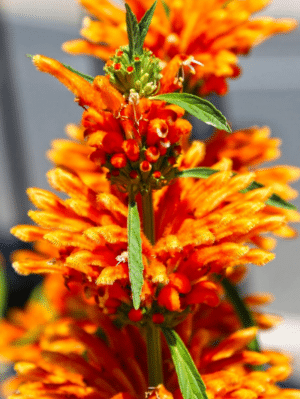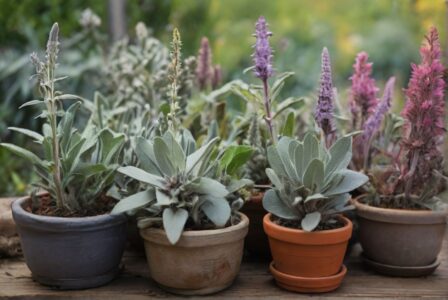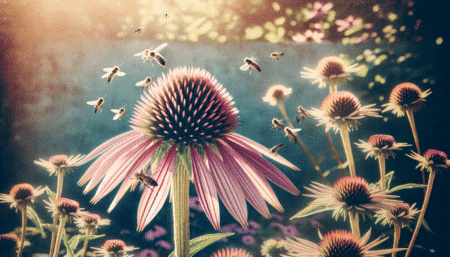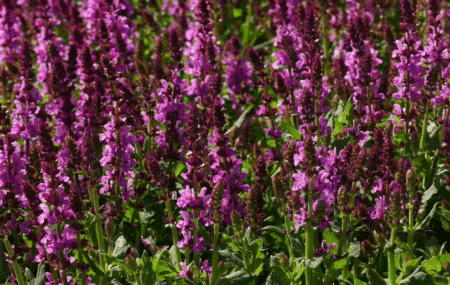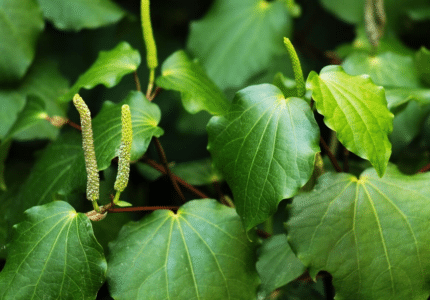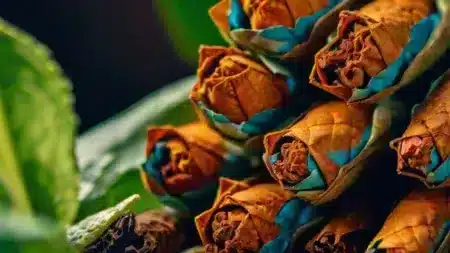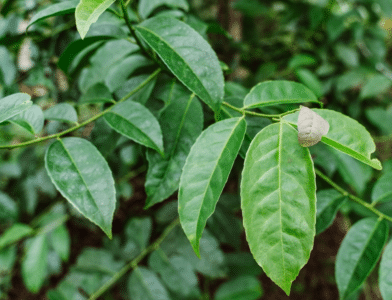- General information about Leonotis leonurus
- History and origin
- Different Leonotis species
- Leonotis leonurus var. "Alba"
- Growing, harvesting and using lion's ear
- Conclusion
Here you can find our Leonotis seeds!
Here you can find our Leonotis leonurus seeds!
Here you can find our Leonotis leonurus var. alba seeds!
Are you interested in the lion's ear, also known as Leonotis leonurus? This plant is perfect for your balcony, patio or garden! With its eye-catching flowers and leaves, it brings an exotic touch to your green oasis. It is easy to care for and you can even order seeds online. Overwintering is also no problem, as the lion's ear can be kept as a houseplant. Try it out and be inspired by this fascinating plant!
1. general information about Leonotis leonurus
Leonotis leonurus, also known as lion's ear, is a fascinating plant with many characteristics that make it a popular choice for garden lovers. Its striking orange flowers and green leaves add a touch of the exotic to any balcony, patio or garden. Caring for these herbaceous items is relatively simple and straightforward. Leonotis leonurus prefers a sunny location and thrives best in well-drained soil. You can either grow it directly from seed or buy ready-made plants. You should make sure that the seeds or plants come from a reliable supplier. Lion's ears are best overwintered in a cool room or conservatory. During the growth phase, the plant needs regular watering and occasional fertilizing to stay healthy. A pot is particularly suitable for growing on the patio or balcony, as it can be positioned flexibly and offers sufficient space for root growth. The leaves and flowers of the lion's ear can be used in a variety of ways - whether for decorating bouquets or preparing teas and other home-made herbal products. In summary, Leonotis leonurus is an interesting houseplant that is both visually appealing and easy to care for. Whether in the garden, on the balcony or in a pot, this plant is sure to delight.
2. history and origin
The lion's ear, also known as Leonotis leonurus, is a fascinating plant with an interesting history and origin. This particular species originates from South Africa, where it is native to the warm regions of the country. It grows wild in the countryside there and is also prized by the locals for its many uses. The historical significance of the lion's ear goes back a long way. It was already used in traditional African medicine to treat various ailments. The leaves and flowers contain essential oils and other active ingredients that can have a calming effect. It is often used to relieve stress and anxiety. Today, lion's ear has also gained popularity outside Africa. Many people appreciate its decorative properties and grow it in their gardens or on their balconies. The striking orange flowers are a real eye-catcher and attract bees and butterflies. Lion's ear is relatively easy to care for. It prefers a sunny spot with well-drained soil. It should be watered regularly in summer, while watering should be reduced in winter to avoid waterlogging. The lion's ear can be kept both in the garden and in a pot on the patio. If you decide to grow the lion's ear, you can purchase seeds or pre-grown plants. There are also online stores that specialize in shipping houseplants and offer a large selection of different varieties. Overall, the lion's ear is a fascinating plant with a rich history and origin. It is not only decorative, but also has medicinal properties. If you're looking for an interesting herb or ornamental plant, the lion's ear could be just the thing for you.
3. various Leonotis species
Leonotis leonurusalso known as "lion's ear", is a fascinating plant that can be found in many gardens and on balconies. But did you know that there are several other Leonotis species besides the well-known species? This variety of lion's ear provides an interesting addition to any garden or balcony. One of the most remarkable Leonotis species is the Leonotis leonurus var. "Alba". In contrast to the typical orange flower of the lion's ear, this variety has beautiful white flowers. The delicate petals are a real eye-catcher and add an elegant touch to any location. The care of these different lion's ear species is similar to that of the well-known Leonotis leonurus. They prefer a sunny location and well-drained soil. Even though they are rather drought tolerant, they should be watered regularly, especially during the hot summer months. To promote the growth and flowering of the plants, it is advisable to regularly remove dead leaves and wilted flowers. This concentrates the plant's energy on healthy growth. If you are interested in growing this particular Leonotis species, you can buy seeds or young plants online or at garden centers. A big advantage is that the plants can also thrive in pots on patios or balconies. So you can easily enjoy them in your own green paradise. The various Leonotis species offer an exciting opportunity to decorate the garden or balcony with unusual flowers. Whether as an eye-catcher in a flower bed or as a solitary plant in a pot, the lion's ear brings color and vibrancy to any outdoor area. Why not try planting this unique Leonotis species in your garden and be enchanted by its beauty!
4. leonotis leonurus var. "Alba"
Leonotis leonurus var. "Alba" is a special variation of the popular lion's ear plant. As with other varieties of Leonotis leonurus, this variant is characterized by its eye-catching flowers. In contrast to the classic orange flower, however, the "Alba" variation has white petals. This gives the plant a charm all of its own and makes it an eye-catcher in any garden or on the balcony. Caring for the "Alba" lion's ear is similar to other Leonotis varieties. The plant prefers a sunny location and should be watered regularly to prevent it from drying out. The leaves can occasionally be stripped to make room for new growth. A special feature of growing Leonotis leonurus var. "Alba" is its overwintering. As the plant is not hardy, it should be brought into a sheltered room in the fall or covered with fleece to prevent frost damage. The flowers of the lion's ear can be used both fresh and dried. They are ideal for decorating bouquets or as an ingredient in herbal teas. The seeds can also be collected and used for propagation. Leonotis leonurus var. "Alba" is definitely an interesting choice for all garden lovers and fans of exotic plants. With its white flowers, it brings a touch of the exotic to the home garden or patio. So if you're looking for an unusual plant, you should definitely give the lion's ear "Alba" a try. You can find high-quality seeds and other Leonotis varieties for your garden in our online store. Order now and have your favorite plants conveniently delivered to your home!
5. grow, harvest and use lion's ear
If you're interested in growing, harvesting and using lion's ear, you've come to the right place! Lion's ear, also known as Leonotis leonurus, is a fascinating plant with many possible uses. Whether on the balcony, terrace or in the garden - the lion's ear feels at home in many locations. You can grow it either in a pot or directly in the ground. Care is relatively simple: make sure there is enough sunlight and keep the soil moist. You can either order the seeds online or collect them yourself from the inflorescences. The leaves and flowers of the lion's ear are both visually appealing and versatile. You can use them for teas or tinctures, for example, and benefit from their health-promoting properties. The leaves are also used in the kitchen as a spice in various dishes. If you overwinter the lion's ear, it is best to keep it in a cool and bright place. With a little patience, you will soon be able to proudly harvest your own! So what are you waiting for? Get started and discover the world of the lion's ear!
6. conclusion
The lion's ear (Leonotis leonurus) is a fascinating plant that can be found in many gardens, balconies and terraces. In this article, we have taken a detailed look at the various aspects of Leonotis leonurus: from its history and origin to the different species and the 'Alba' variety. We have learned how to successfully grow, harvest and use the lion's ear. Now it's time for a conclusion. The experience of many gardeners shows that the lion's ear is an extremely robust and easy-care plant. It thrives magnificently both in the garden and in a pot on the patio or balcony. With its striking orange flowers and hairy leaves, it not only attracts bees and butterflies, but also adds an exotic touch to any garden. Anyone interested in herbs should definitely consider the lion's ear. Its leaves can be used as a spice in the kitchen and give dishes a spicy flavor. Lion's ear also has medicinal properties and is traditionally used to treat various ailments. Buying Leonotis leonurus seeds or young plants is easy, as they are available online or in specialist garden stores. They are usually shipped quickly and reliably. The plant can be overwintered either indoors or protected in the garden, depending on the individual climatic conditions. Overall, the lion's ear is an impressive plant that impresses with its beauty and versatility. Whether as a houseplant, in the garden or on the patio - Leonotis leonurus enriches any location. With a little care and attention, it is sure to become an eye-catcher in your green paradise. Give it a try and be enchanted by this extraordinary plant!
Further questions and answers about Leonotis leonurus
Is lion's ear hardy?
Yes, the lion's ear is hardy. It is a perennial plant that generally copes well with cold temperatures. The lion's ear, also known as Leonotis leonurus, originally comes from the warm regions of South Africa. Nevertheless, it can also survive in temperate climates as long as it receives adequate protection in winter. As a rule, the lion's ear should be cut back before the onset of winter. This minimizes the risk of frost damage. It is also advisable to apply a thick layer of mulch around the base of the plant to protect it from heavy frost. While the lion's ear is hardy, it can still be affected by extremely cold temperatures. In areas with very harsh winters, it may be necessary to take additional measures, such as covering the plant with fleece or moving it to a sheltered area. Overall, the lion's ear is a robust and hardy plant. With a little preparation and protective measures, it can easily survive the winter and flower again in spring. However, it is advisable to adapt to the specific climatic conditions of your region and, if necessary, obtain further information on caring for the lion's ear in winter.
When does African lion's ear flower?
The African lion's ear, botanically known as Leonotis leonurus, flowers mainly in the summer months. However, the flowering period varies depending on the climate and geographical location. In most regions of Africa, the flowering period begins in late spring or early summer and lasts until fall. The eye-catching orange flowers of the African lion's ear form in dense inflorescences that resemble the shape of lion's ears. This perennial plant is known for its attractive appearance and its attraction to pollinating insects such as bees and butterflies. The African lion's ear prefers sunny locations with well-drained soil. It can thrive in various habitats such as meadows, open forests or coastal areas. In some areas, it is also cultivated as an ornamental plant in gardens. The flower of the African lion's ear is not only aesthetically pleasing, but also has cultural significance. In some African cultures, it is traditionally used for medicinal purposes to alleviate various ailments. Overall, the flowering period of the African lion's ear is an impressive time when this plant displays its full beauty and makes an important contribution to insect pollination.
Related links to Leonotis leonurus
- https://www.mein-schoener-garten.de/pflanzen/loewenohr/loewenohr
- https://www.flora-toskana.com/de/dauerblueher/374-leonotis-leonurus-afrikanisches-loewenohr.html
- https://de.wikipedia.org/wiki/L%C3%B6wenohren
YouTube
Note: The information in this article is for informational purposes only and is not intended to replace the advice of a physician or other healthcare professional. Always consult a doctor before using any new herbs or supplements. Furthermore, you should always check whether the cultivation/possession/use/processing of certain plants is permitted in your country. As we only offer ornamental plants in our store, we are allowed to only Provide information and advice on the correct care of plants!

